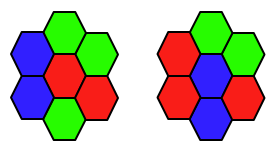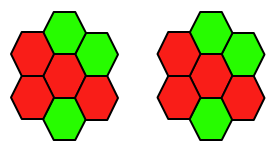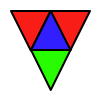Many years ago I devised a strange concoction that I call trinary life. This is a version of Conway’s Game of Life, also known as cellular automata. Conway’s version is binary: each cell can be either on or off, and there’s a rule specifying how cells change state based on the states of their neighbors. My version is trinary rather than binary: each cell can take one of three values: Red, Green, and Blue. Each cell changes state base on the states of its neighbors and an intransitive combat relationship between them: Red beats Green, Green beats Blue, and Blue beats Red.
I wonder if the concepts of Trinary Life can be applied to dream combat? Let’s think on it. We must start with a grid work of colors; should this grid work be rectangular or hexagonal?
The hex grid seems the more appropriate given the trinary nature of the auras, but this creates an interesting new problem: what’s the transformation rule for a hexagon? It has six neighbors. What would this map represent? How would the player play it? Perhaps the player could use a hex-wheel, like so:
This hex-wheel represents his aura-constitution. Every acolyte has seven auras, and in dream combat the two hex-wheels are lined up against each other and each hex interacts with its corresponding hex. For example, suppose that we had these two hex-wheels from two players in dream combat. Before combat:

After dream combat, they’d look like this:

Wow! That’s mighty peculiar! Was it a special property of this set of hex-wheels, or is it intrinsic to the system? I think it’s intrinsic, which would be very bad. Yes, it’s definitely intrinsic.
But I have another idea: since this is trinary, why not use a plane tiled with triangles; we’d want a convex figure:

I like the cleanliness of the left (smaller of the two). Moreover, the three wings can be folded to make an equifacial pyramid.
Here’s another possibility: there are seven species, and a hexagon surrounded by six other hexagon makes seven hexagons. Call that a flower. Perhaps the goal should be to build a flower with yourself at the center, which you do by altering your hexagon so that it is “perfect” – i.e., it has exactly two of each aura.
None of this, however, addresses how dream combat is carried out, or what the player must learn in order to prevail in dream combat. If we assume that the dream combat remains the same (rock-scissors-paper), then here are the possible goals in order of complexity:
minimum number of auras of any kind
a “balanced” set of auras (N of each of the three auras)
a specified geometric arrangement of auras
I have to confess that, in game terms, the first is the simplest, cleanest, and most playable. It’s what I used in the original Siboot. I was hoping that I could come up with something better. But so far the answer has eluded me.
